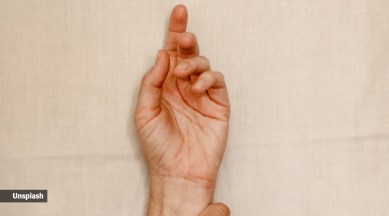📣 For more lifestyle news, click here to join our WhatsApp Channel and also follow us on Instagram
Know Your Body: What is nerve flossing, and can it actually help ease numbness in the hands?
Nerve gliding or nerve flossing exercise is usually used in rehabilitation programs and during the post-surgical period, said Shalom Abraham, lead physiotherapist, Manipal Hospital, Old Airport Road, Bangalore

Whenever we start our hunt for a new piece of interesting information about the human body, we are left stumped by the amount of information and trivia available — all of which we have vowed to share with you as part of our ‘Know Your Body‘ series. So, in keeping with the promise we have made, we are back with yet another piece of the nugget — this time to help you manage that numbness and tingly feeling in your hands.
All thanks to Kristi Barker, a physical therapist, who introduced us to the concept of “nerve flossing”, after she shared a few stretches that she said can help tackle numbness in the hands. Yes, turns out, flossing is not just for your teeth, but even your hands can do with some ‘flossing’.
monthly limit of free stories.
with an Express account.
“Have you heard of the term ‘flossing” your nerve’? and I am not referring to dental floss! Nerve flossing is a way to improve your nerve mobility! Our nerves should move and glide just like our muscles do! Sometimes they get compressed and irritated when they aren’t moving enough,” she captioned the video, adding that the exercises shared target the median nerve, which is one of the main culprits for carpal tunnel syndrome.
She demonstrated the following practices:
Median nerve — Flap your hands sideways. Repeat on the other hand.
Ulnar nerve – Place your thumb on the ring finger and fold your hand to your neck. Repeat on the other hand.
Radial nerve — Make a fist and take your hand back. Repeat on the other hand.
She, however, cautioned against holding it on a static stretch as it “will make symptoms worse”.
Why do you experience numbness?
Dr Ankit Batra, orthopaedic surgeon, Sharda Hospital said that all nerves have various points along their respective courses where compression is common as they are surrounded by bony and soft tissue structures and pass through very narrow tunnels, canals, and spaces. “Compression neuropathy, like carpal tunnel syndrome from using the keyboard or writing too much, along with vitamin B12 deficiency, diabetic neuropathy, traumatic nerve injury, excessive stretching, etc can all cause numbness in the hands,” he said.
Does nerve flossing work?
Nerve flossing is also called nerve glide or nerve stretching. “It is a kind of exercise that is said to improve neurodynamics to mobilise compressed or irritated nerves. This allows the nerve to glide freely along the movement of the joint,” said Shalom Abraham, lead physiotherapist, Manipal Hospital, Old Airport Road, Bangalore.
Where is it used?
According to Abraham, nerve gliding exercise is usually used in rehabilitation programs and during the post-surgical period. “These exercises are performed around the mid-range of joint movement,” said Abraham.
The most common conditions that require nerve gliding exercises are carpal tunnel syndrome, cubital tunnel syndrome, piriformis, and sciatica. The therapist prescribes different nerve gliding exercises for different nerves in order to maximise their function, Abraham said.
However, Dr Batra warned against unsupervised nerve gliding. “It’s inadvisable and can cause more harm than good. I’ve never seen any sane surgeon prescribe it. That is because patients tend to jerk and do random and wrong movements which further aggravate their pain and make diagnosis and prognostication difficult,” Dr Batra stressed.
Things to keep in mind
*Nerve gliding exercises should be done several times daily or as prescribed by the physiotherapist depending on the condition and under supervision, said Dr Abraham.
*In case of sudden aggravation of pain, unexplained weakness, or severe numbness, avoid the stretch, experts warn.
📣 For more lifestyle news, follow us on Instagram | Twitter | Facebook and don’t miss out on the latest updates!
📣 For more lifestyle news, click here to join our WhatsApp Channel and also follow us on Instagram